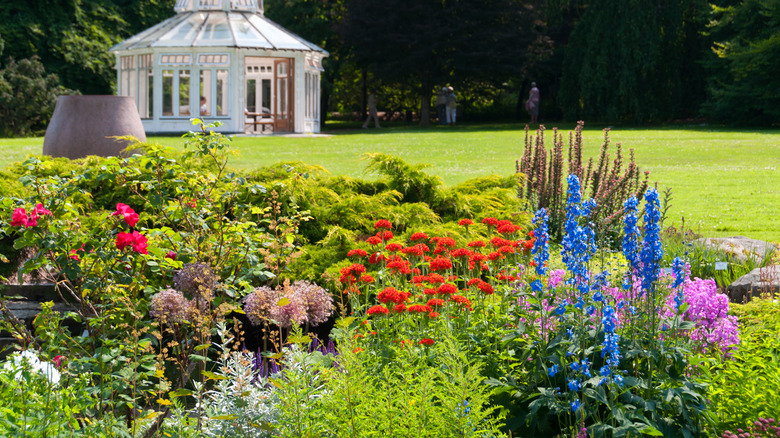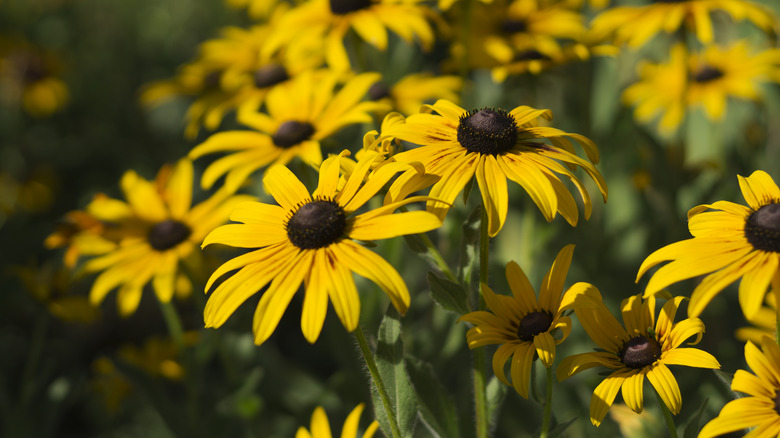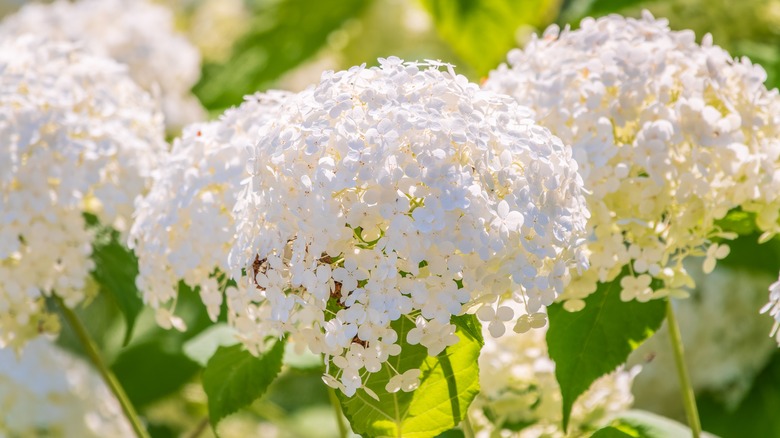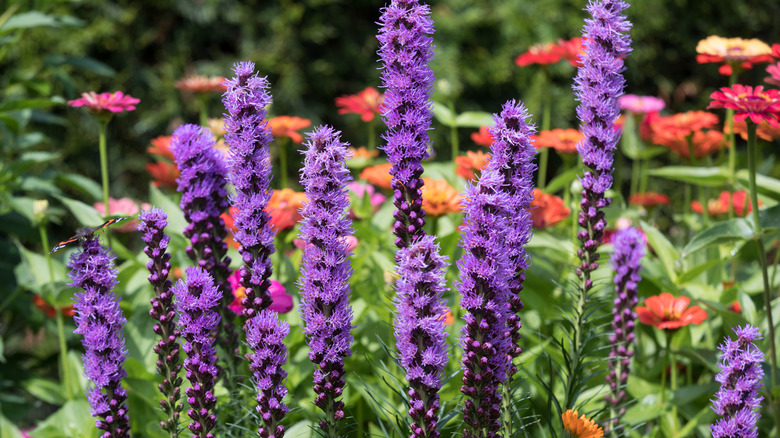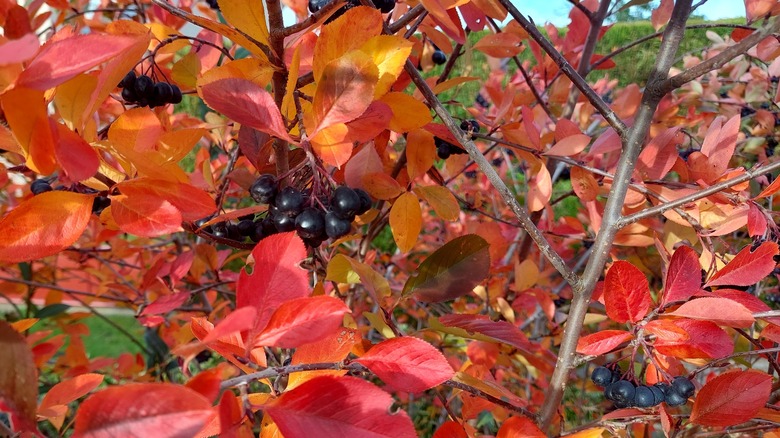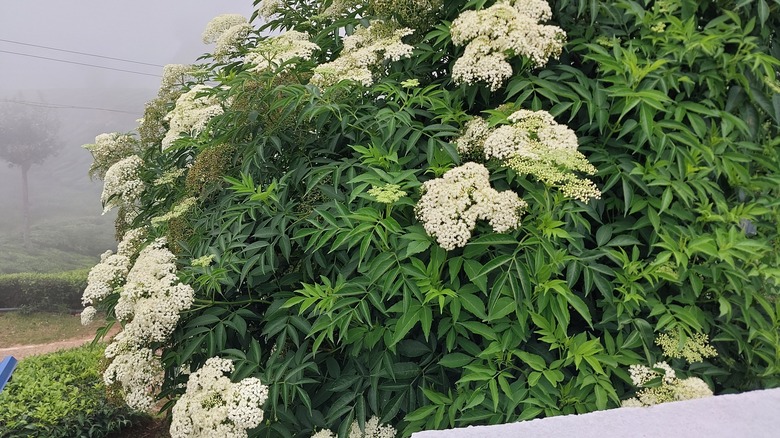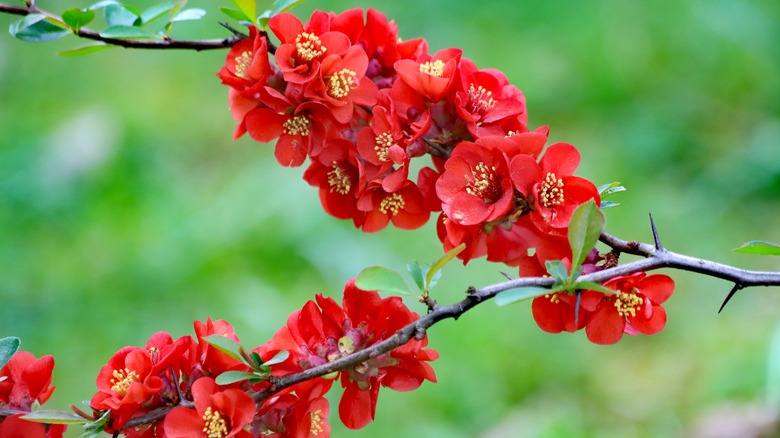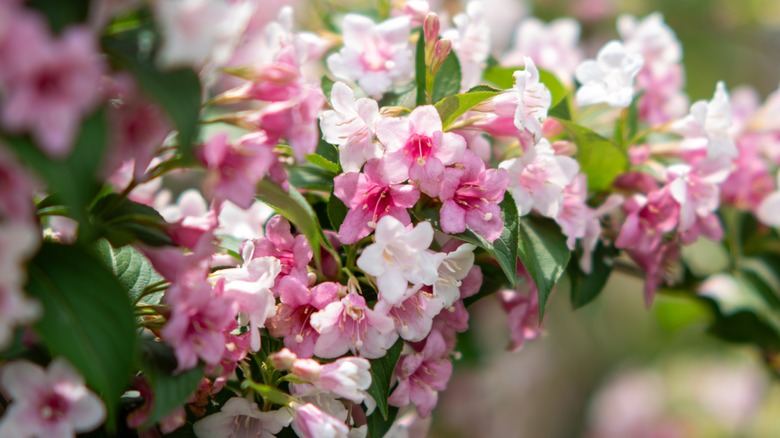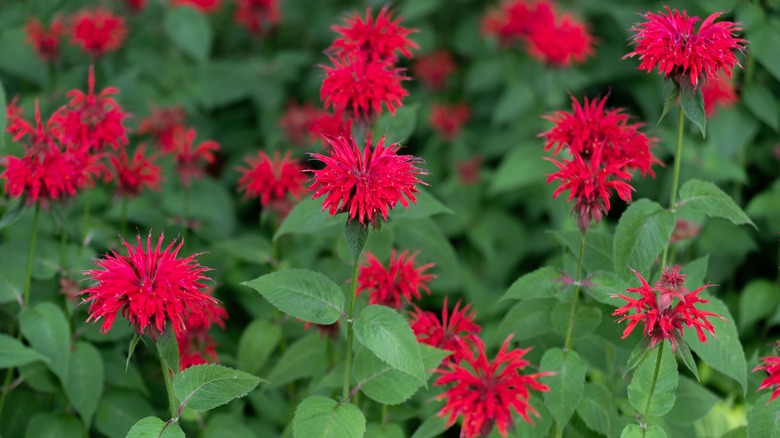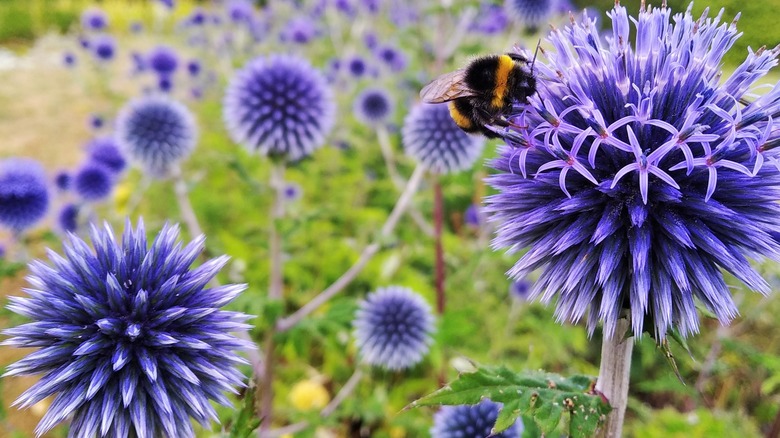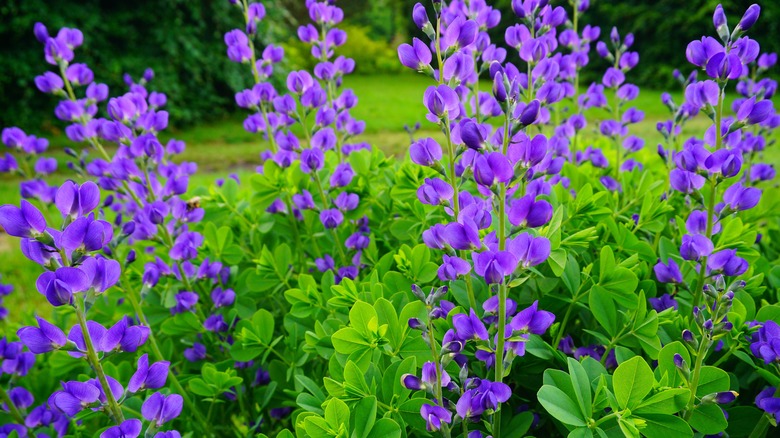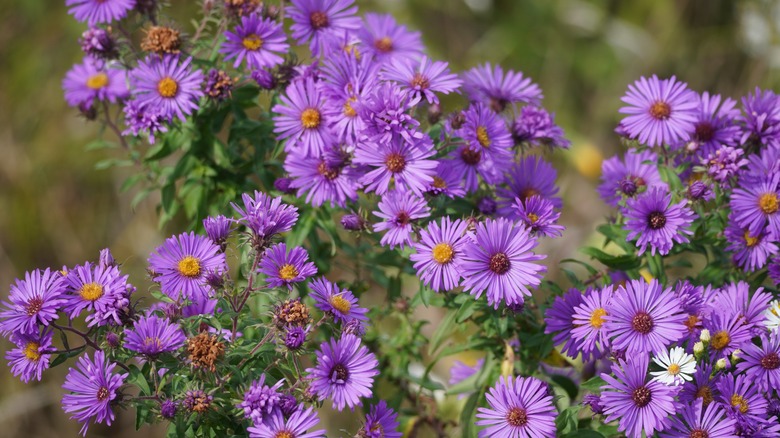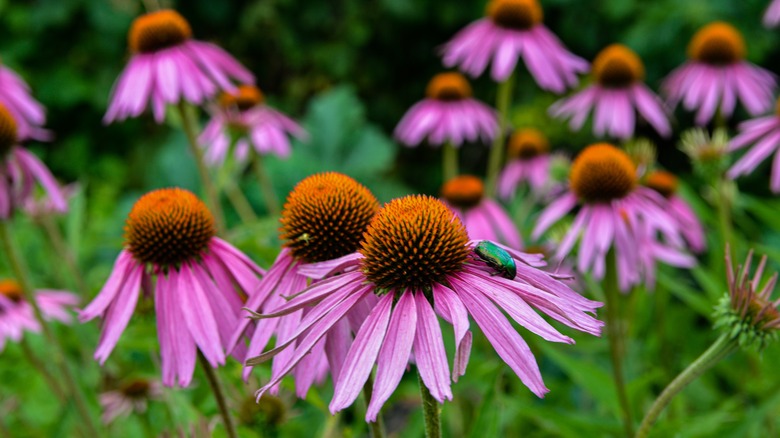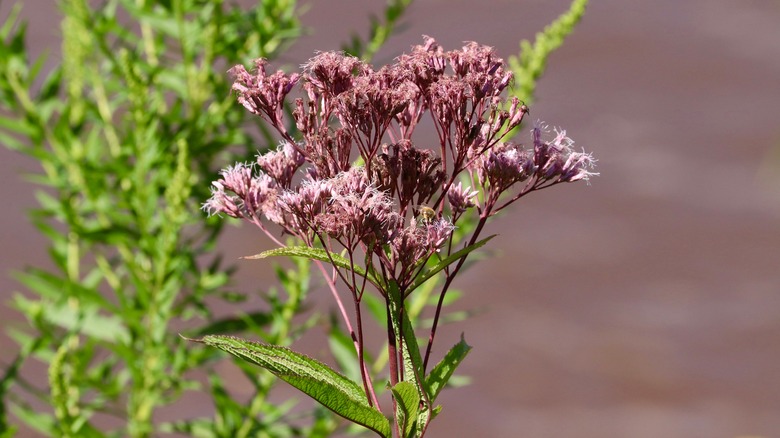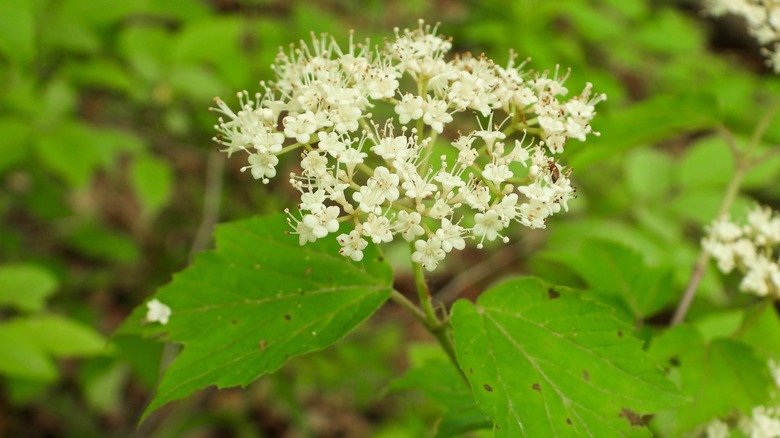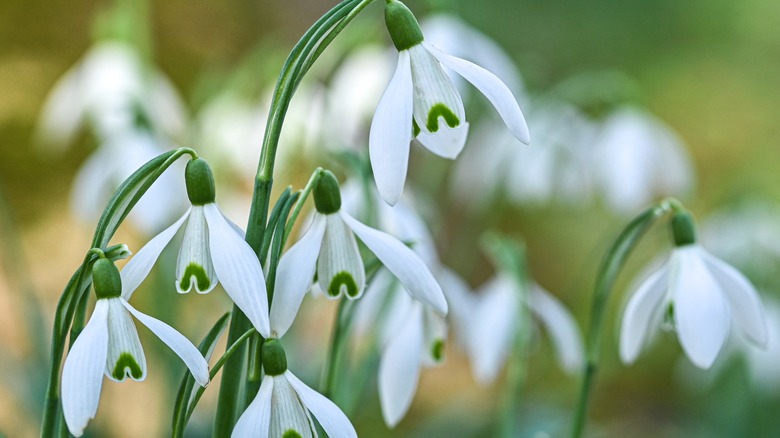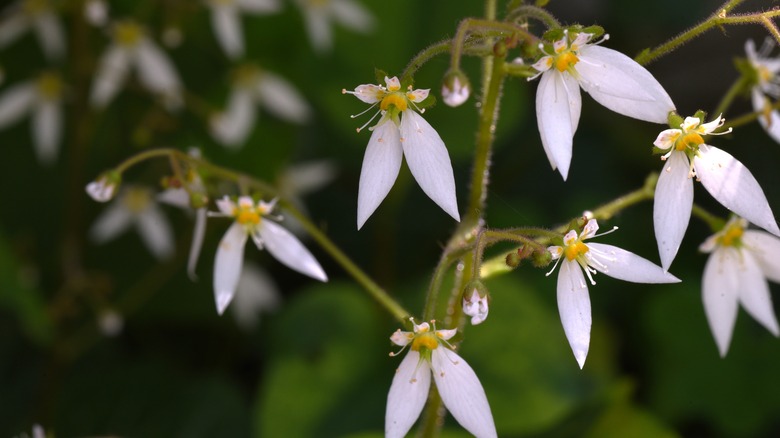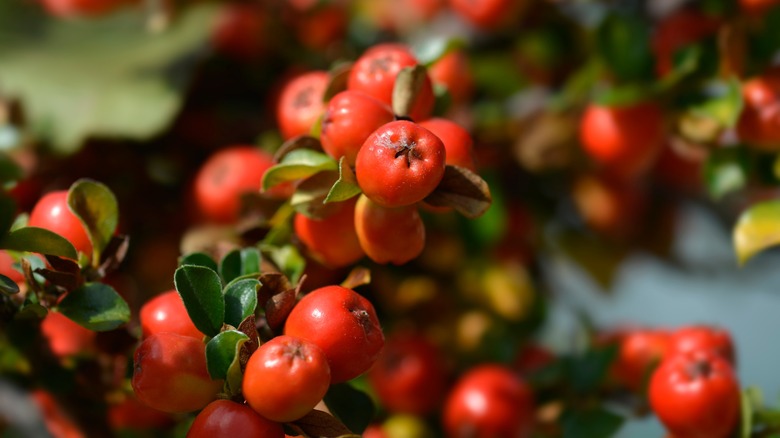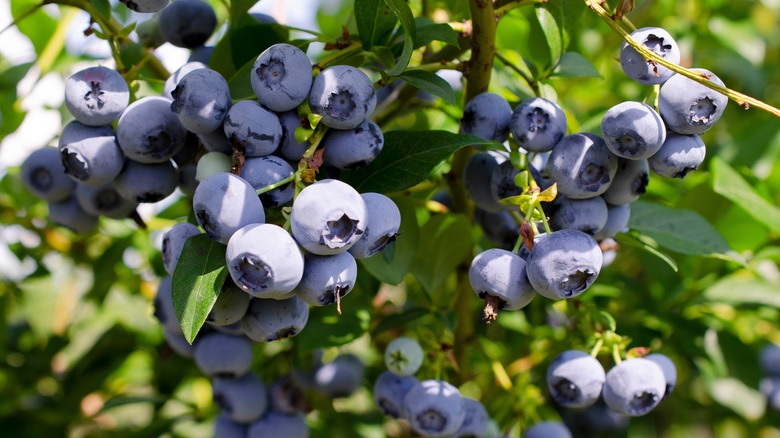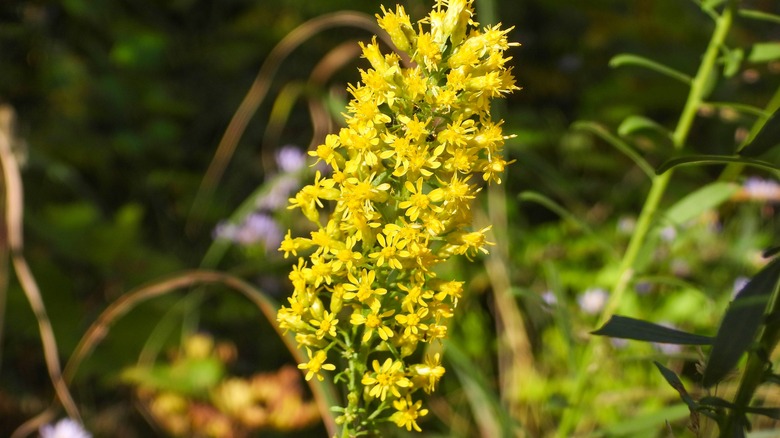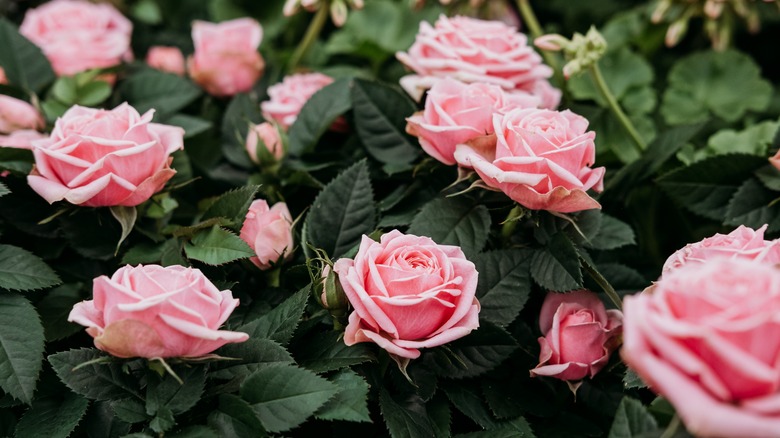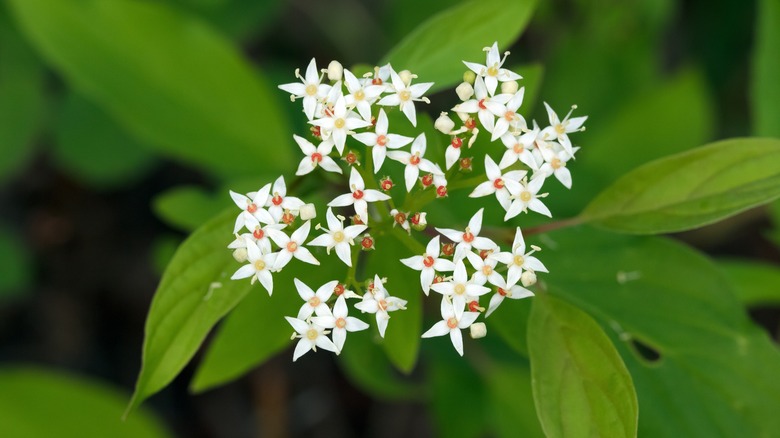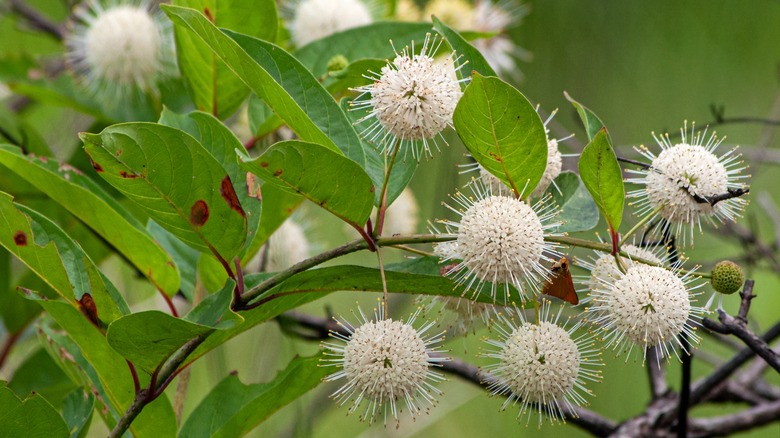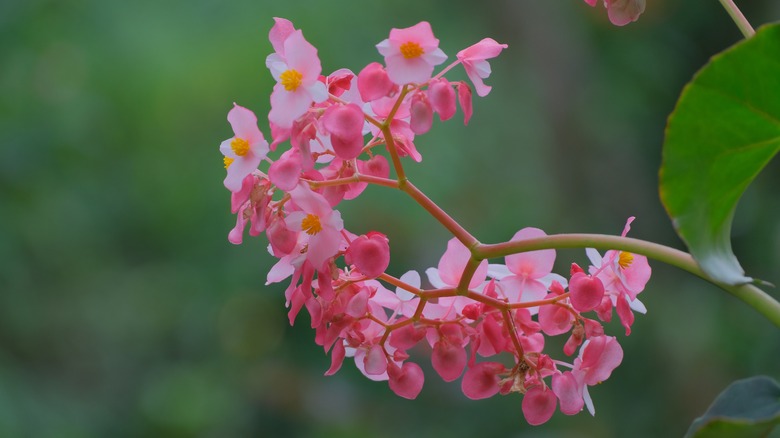23 Beautiful Plants That Will Thrive In Clay Soil
For some home gardeners, closing the distance between them and a breathtaking landscape requires treading through clay soil. Alas, it isn't the best path, both for your boots and plants. Indeed, the Utah State University Extension asserts that when a soil's clay content exceeds 30% — you can ascertain your soil's composition with a simple glass jar soil test — it has trouble draining excess water. Air circulation isn't the best either, with most plants left gasping for oxygen, on top of having to knead their way through the compact substrate. Working through the hardpan material with your garden implements isn't any easier.
But like most things, there's a copper silver lining to clay soils, including high fertility. Their negatively charged, tiny pores cinch nutrients into the soil, lowering the need for fertilization. Their predisposition to hold water becomes worthwhile during droughts, unless they've already forced the plants' allegorical hands into growing shallow roots. The cherry on top? Some plants really appreciate the clay texture. Prime examples include Annabelle hydrangeas, weigelas, black-eyed Susans, elderberry, and more. That said, there's no taking away the fact that you must amend your clay soils for better drainage. Dress it with a topsoil in a 2- to 3-inch-thick layer of composted organic matter without working it in.
1. Black-eyed Susan
Endemic in the eastern U.S region, the black-eyed Susan (Rudbeckia hirta) is a brown-eyed, bright yellow perennial that succeeds in moist (not soaking wet) clay soils, provided it's given full to part sun. Not to be confused with black-eyed susan vines (Thunbergia alata), these native wildflowers enables pollinators and birds to benefit from their spring through summer-lasting floral display. Growing almost 4 feet tall and half as wide, they're hardy in zones 3 to 8. Watch out for powdery mildew and rabbits, and don't go overboard with nitrogen fertilizers.
2. Smooth hydrangea
Aglow in white, pink, or green, dome-shaped flowers from spring through summer, smooth hydrangeas (Hydrangea arborescens), particularly the Annabelle cultivar, (the hydrangea variety that loves a massive pruning) can bloom in heavily compacted clay soils. These deer-resistant plants host droves of butterflies, songbirds, and moths, providing an easy gateway to starting a pollinator garden. Deadhead the spent blooms to encourage a late-season flush but watch for aphids and blight. Adaptive in zones 3 to 9, the nearly 5-foot tall plants prefer partially shaded spots, but may accept sunlight for longer if sited in consistently moist soils.
3. Dense blazing star
Widespread along the swampy eastern U.S., the dense blazing star adds structure to any yard with its slender, rose-purple (occasionally white) feathery inflorescence that unfurls top to bottom from midsummer to early fall, all the while charming songbirds, bumble bees, and moths. Usually low-maintenance, the bulbous perennial may need staking when grown in highly fertile, moist mediums. Grow in sunny (or mildly shaded) sites in zones 3 to 8 and watch the plant touch 6 feet in height. However, be alert, as the plant may escape its bounds, for it self-seeds and grows suckers.
4. Black chokeberry
Courtesy of its violet-black pomes being chockful of antioxidants, the native black chokeberry (Aronia melanocarpa) has become a quintessential berry plant, especially if it's overlaid in poorly draining, compacted clay soils. The low-maintenance shrub services songbirds in late winter with food and shelter and charms its onlookers with pinkish-white flower clusters and glossy red fall foliage from spring into summer. Site it at the back to mask its 8 feet tall, albeit narrow (1 ½ feet across) gangly limbs in part to full sun. It is winter hardy in USDA growth zones 3 to 8.
5. Common elderberry
With their lavender-black drupes used in wines (or as songbirds' snacks), fragrant white flowers brewed for teas, and big-leaved greenish-yellow foliage standing as a nesting items for local bees, the elderberry shrubs (Sambucus canadensis) have scores of uses. Populating and stabilizing your clammy sites in zones 3 to 9 with their water-sucking, shallow roots is another. However, grow multiple varieties successively for cross-pollination and extended spring through summer floral bonanza. The natives grow between 5 and 12 feet tall and equally wide in full sun to slight shade.
6. Flowering quince
Birthing the quince fruit that you can pluck off its copper stems for jellies, assuming hummingbirds have spared some, flowering quince (Chaenomeles speciosa) is a profuse bloomer of scarlet pink inflorescence. They're at home in sunny gardens of zones 4 to 8 but are just as unfussy in dappled shade. As they sprout pretty thorns, they work better as espaliers or hedges — the 10-foot tall and 12-foot wide frame helps, too. But in mixed borders, their nearly thornless Double Take series is more befitting, with mid-spring through late summer getting even bigger flowers.
7. Weigela
Blowing their burgundy or white trumpet flowers to call forth hummingbirds into your garden, weigela shrubs (Weigela florida) can be planted in drifts, as border hedges, or living screens in clay soils in zones 4 to 8. Their variegated purplish-green foliage adds gorgeous fall interest and can be left unpruned to achieve a fountain look, although it might appear unkempt to some. Grow in full to part sun to achieve the incredible winter interest that heralds in spring. Their award-winning, deer-resistant Wine and Spirits cultivar is exceptionally fetching. Weigela spreads between 6 and 10 feet at maturity.
8. Scarlet bee balm
Named after its ability to relieve bee bites, scarlet bee balm (Monarda didyma) has a place in the boggy spots of your perennial borders. Dotted with two-lipped, edible, burgundy flowers from summer until fall, the mint-smelling herb plays a crucial role in supporting pollinators, including fritillaries and ruby-throated hummingbirds. Although the low-growing plant is deer and rabbit-resistant, it can take over your garden, so make sure to prune before it seeds. It's cold hardy in zones 4 to 9 with full to dappled sun exposure. The native tops out at 4 feet while measuring 3 feet across.
9. Globe thistle
Blanketed in a globulus mass of star-shaped, purplish-blue flowers, globe thistle (Echinops ritro) is a deciduous plant that can boost bees while keeping deer out of your garden. Fortunately, its over 8-inch-long leaves are equally attractive — typified by silver-green tops and white undersides — as are the fruits that persist through the fall. However, you must pop it only in nutrient-poor soils with maximum sun exposure, or else be ready to stake its leggy stems. Growing over 2 feet tall and similarly wide, the rabbit-resilient perennial withstands the cold winters of 2 to 8. Tolerates partial shade.
10. Blue false indigo
Troopers against deer, blue false indigo (Baptisia australis) plants sprout clover-like, bluish-green leaves, adorned by almond-esque, purple, blue, or golden flowers during spring into early summer. Pollinator-friendly black pods grow out eventually, adding decorative appeal during the winter. Specially adapted to acidic, clay soils of zones 3 to 9, these natives can occasionally tolerate standing water or drought. However, unless you're saving seeds for next year, prune the wildflower after flowering to prevent spreading. Site in full sun or provide support if maintained in somewhat shaded spots. It approximates 4 feet tall when it comes off age.
11. New England aster
To turn your sticky yard into a rest stop for monarch butterflies, hoverflies, and songbirds, grow New England aster (Symphyotrichum novae-angliae), a stunning perennial native to the Eastern North American region. The nearly 7-foot-tall herb puts out massive, sunny-eyed, violet blooms late summer through fall that can be cut for arrangements, making way for dry seeds that contrast well with the wintry backdrop. The deer-resistant, 3-foot wide plant can be paired with tall goldenrod in mixed beds in zones 4 to 8, assuming they receive full to part sun.
12. Purple coneflower
Starring summery, brown-disced, daisy-esque flowers whose lilac rays perk down as they mature, purple coneflower (Echinacea purpurea) is a standout choice in gardens with dry, cakey soils. Although it withstands moist conditions, too. The medicinal plant requires a minimum of four hours of sun exposure when planted in shaded areas, otherwise favoring full sun in USDA zones 3 to 8. Armed with numerous cultivars with diverse variations in form, color, and phytophthora rot resistance, it generally stays within 4 feet. Unless goldfinches clear out the patch, the self-seeding plant returns year after year.
13. Joe Pye weed
If you were hoping to turn your yard and garden into a bird haven but thought wet clay soils play spoilsport, consider Joe pye weed (Eutrochium maculatum) — a perennial wildflower endemic in the eastern U.S. region. Clad in aromatic rosy-purple flower clusters during mid-summer, outlasting fall, the deer- and rabbit-tolerant plant keeps honey bees and butterflies interested, albeit taking damage from flea beetles. Adaptive in zones 3 to 8, the 4-foot wide plant prefers full sun. However, it must be shaded during noon to prevent leaf scorch. Cut back the plant in winter to intercept colony-building rhizomes.
14. Mapleleaf viburnum
Coveted for its maple-like golden-green leaves that celebrate fall's arrival by turning a flaming pink, purple, or orange, mapleleaf viburnum (Viburnum acerifolium) is a hardy perennial for acidic clay or rocky soils in zones 4 to 8. It keeps the area vivacious through bluish-black berries on tan or white flowers that entice cedar waxwings, American robins, and other pollinators through spring and summer. However, you'll need to plant at least two of them for cross-pollination; it doesn't have to be side-by-side. Make sure it's a dappled or deeply shaded spot. It grows around 6 feet wide and tall.
15. Common snowdrop
With daffodils for cousins, snowdrops (Galanthus nivalis) have etched a place for themselves as a pharmaceutical and an ornamental. They beckon the spring season by rearing their cream-white flowers from the snow-carpeted ground atop leafless verdant stalks. They're best planted as bulbs during the fall, as seeds take almost four years to flower, and must be planted in groups of four to have the best effect. Cold hardy in USDA zones 3 to 9, snowdrops measure less than a foot by maturity and expect ample sun exposure, but may endure some shade if forced.
16. Strawberry begonia
Often found gracing hanging baskets or window sills as a houseplant, strawberry begonia (Saxifraga stolonifera) or mother of thousands can be used as groundcover in shaded sites with viscous clay soils. When it isn't blooming airy, five-petaled white flowers during the spring-summer transition, it rocks the garden with its fast-spreading, silver-veined, heart-shaped (like begonias) green leaves with maroon-purple undersides, eventually forming matted colonies. The barely 1-foot tall plant survives zone 6's winters with mulch and is otherwise adaptive through zone 10. Pop in a heavily shaded area for it isn't very tolerant of sun.
17. Cranberry cotoneaster
For those with compacted clay soils in zones 4 to 7, cranberry cotoneaster (Cotoneaster apiculatus) presents a way out. Their slow-growing sprawling mounds envelop the ground with diminutive pink buds that blossom into stellate whitish-pink flowers from late spring through summer. Turning bronze-scarlet come fall, their foliage offers some color interest, as long as they have full to part sun. However, the real show-stealers are their red berries that songbirds nibble through hardy winters. Pair them with roses, dogwoods, or magnolia shrubs in mixed borders. They extend between 3 and 6 feet across while standing 3 feet tall.
18. Highbush blueberry
If you have highly acidic soils (pH levels approximating 5.0), highbush blueberry plants (Vaccinium corymbosum) are a worthy call both for fruits and flowers. The spring bloomers grow urn-like, nodding white or pink flowers between February and June, with their edible blueberries emerging two months later. However, you must remove all the flowers going forward for a better harvest or plant different cultivars successively to improve pollination. Plant in drifts in sunny (or mildly shaded) gardens in zones 3 to 8. Alternatively, use the 12-foot tall and 10-foot wide shrub as a fence or a screen.
19. Showy goldenrod
Keeping to its name, showy goldenrod (Solidago speciosa) grows a pyramidic inflorescence of blonde-yellow flowers, attracting late-summer pollinators (including bees and butterflies) with songbirds flocking into the yard during the fall for seeds. Deadheading brings about another flush while preventing self-seeding when they're grown in sunny, moist beds. However, separate the native plant's clumps every couple of years to prevent them from spreading into the rest of your garden. Once mature, the perennial stands over 2 feet tall and wide while repelling deer. It grows in zones 3 through 8.
20. Roses
Boasting a gamut of shapes (think floribunda, grandiflora, hybrid tea, miniature, and the like) and a spectrum of colors — sometimes even changing colors in the garden, roses (Rosa spp.) leave their growers stumped, mesmerized, and pinning for more, despite their unending pest and disease problems and diva nature. But if you can improve your clay soil drainage, they'll reward you with fragrant blooms while keeping birds happy with red hips. At home in USDA zones 5 to 11, the summer bloomers thrive in full sun, especially during the mornings, but appreciate some shade during the hotter afternoons.
21. Red osier dogwood
Massed in groups, or used as specimens, red osier dogwoods (Cornus sericea) maintain four-season interest in boggy sites. Their juvenile branches are a striking crimson, contrasting beautifully with the ivory-white or greenish-yellow flowers in spring. Their blue-tinged white fruits last into fall, sustaining songbirds, bees, and butterflies, falling off eventually to reveal purplish-red twigs that persist through the winter chill. Pruning these natives' root suckers is essential to contain their sprawl. Site in full sun or part shade in growth zones 2 to 7. The North American native matures upwards of 5 feet in height and spread.
22. Buttonbush
If compaction, frequent flooding, poor drainage, or heat ail your yard, with rocky or clay soils to boot, plant buttonbush (Cephalanthus occidentalis), a moderately deer-impervious native shrub. The low-maintenance, disease-resistant plant is late to green up but electrifies the landscape with impressive maroon or orange foliage in the fall. Other times, it features numerous pincushion-like white flowers that maintain summer-long interest, keeping hummingbirds, moths, and butterflies busy, despite opening up for under four days. Growing over 6 feet tall and equally wide, it's best placed in sunny sites in zones 5 to 11, although it endures light shade.
23. Hardy begonia
An heirloom variety, hardy begonia (Begonia grandis) is prized for its mass of perfumed pink flowers that love ravishing next to their olive green foliage. If planted in part sun, the rays bring out the red veins of the leaves' undersides. However, they adapt to deep shade, too. The pollinator-friendly plant loves mildly acidic soils and has a sprawling growth habit. Although hardy in zones 6 to 9, it must be mulched heavily during the winter up north. Keep curious toddlers and furry companions away from the 3-foot-tall plant, as it's mildly toxic.

